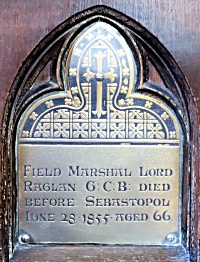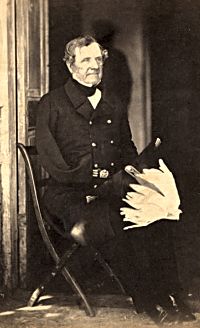The plaque is on the back of one of the choristers stalls in the chancel.
North side, back row, third from the west end.

Portrait

Portrait of Lord Raglan, 1855
From the Roger Fenton Catalogue
The Library of Congress
Rep.No. LC-USZC4-9348
RAGLAN G.C.B. DIED
BEFORE SEBASTOPOL
JUNE 28 1855 AGE 66.
Further Information
Lord Raglan, eighth son of the fifth Duke of Beaufort, entered the army in his 16th year, and in 1807 served on the staff of the Duke of Wellington in the expedition to Copenhagen. As Lord Fitzroy Somerset, his name became a household word. He was present at all the great actions of the Peninsular campaign. He was among the first to mount the breach at the storming of Badajoz, and it was to him the Governor gave up his sword.
On the return of Napoleon from Elba, he served under the Duke in Flanders, and lost his sword arm at Waterloo. From 1827 to 1852, he was military Secretary to the Commander-in-Chief. On the death of the Duke, in September of that year, was made Master-General of the Ordnance, and in October was called to the House of Peers as Baron Raglan of Raglan. In 1854 he was appointed commander of the English forces which were despatched to Turkey.
The victory of the Alma, the flank march to Balaklava, the sanguinary struggle at Inkerman, (which obtained for him the baton of Field Marshall) and the siege of Sebastopol, will ever be closely connected with the name of Raglan. Early in June, 1855, he suffered from a slight attack of cholera, which became at last violent and carried off the great soldier on the 28th June 1855. His Lordship received the gold cross and five clasps for Fuentes d'Onor, Badajoz, Salamanca, Vittoria, Pyrenees, Nivelle, Nive, Orthes and Toulouse; and the silver war medal and five clasps for Rolcia, Vimiera, Talavera, Busaco and Cuidad Rodrigo. He also received the Crimean medal and clasps for Alma, Balaklava and Inkerman, and a large number of foreign orders.
[From the 1873 Guide to the Church]
Archdeacon HP Wright, author of the Guide to the Church was present at the death of Lord Raglan and reported it in the guide as follows:- "The room was small and with little furniture in it. Colonel Somerset and Lord Burghersh stood on one side of the neat narrow camp bed, Dr Prendergast at it's head, Colonel Steele and General Airey on the other side. I stood next, close to the dying hero. As I uttered the words 'peace to this house and all that dwell in it' all fell on their knees. At the close of the heart searching service, I placed my hand upon the broad, handsome forehead of the noble soldier, and commended the departing soul to the keeping of God. A few minutes after the great man went to his rest...."
See Also
Wikipedia
